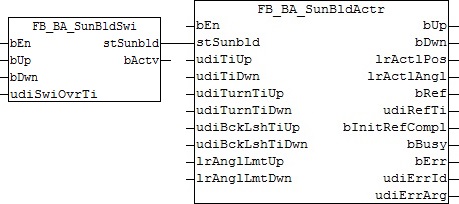FB_BA_SunBldSwi
With the help of this function block the blind controller FB_BA_SunBldActr or the roller blind controller FB_BA_RolBldActr can be controlled in manual operation mode. The connection takes place via the positioning telegram stSunBld either directly or with an additional priority controller.

Functional description
Structure of the blind positioning telegram stSunBld.
TYPE ST_BA_SunBld:
STRUCT
lrPos : LREAL;
lrAngl : LREAL;
bManUp : BOOL;
bManDwn : BOOL;
bManMod : BOOL;
bActv : BOOL;
END_STRUCT
END_TYPE
Operation
In manual mode, the function block controls the blind function block FB_BA_SunBldActr or the roller blind function block FB_BA_RolBldActr via the command inputs bUp and bDwn; bUp has priority. The commands are passed on to the respective commands bManUp and bManDwn of the positioning telegram. If a command input is activated for longer than the entered time udiSwiOvrTi [ms], the corresponding control command latches. Activating a command input again clears this latching.
When the function block is activated via bEn, the bit bActv is set immediately in the positioning telegram. The function block uses this to notify a priority switch (FB_BA_SunBldPrioSwi4 or FB_BA_SunBldPrioSwi8) of its priority over lower priorities. The function block only knows two modes: manual movement via bUp and bDwn, with the result that the bit bManMod is set in the positioning telegram, thereby preventing acceptance of automatic positioning commands by the actuator function block. The second mode is the scene call via bClScn. Via the positioning telegram, this specifies a position and an angle for the scene selected via udiSlcdScn (selection of the field arrSunBldScn). The manual mode bit in the positioning telegram bManMod is deleted, and the actuator function block knows that it has to move to a particular position. The input bClScn is regarded as subordinate to the manual commands. If, in the first cycle of the function block activation (bEn) neither bUp, nor bDwn, nor bClScn are set, the function block "jumps" to manual mode (positioning telegram: bit bManMod) and in this case behaves just like FB_BASunBldSwi.
Linking to the blind function block
The manual mode function block can be connected either via an upstream priority control FB_BA_SunBldPrioSwi4 or FB_BA_SunBldPrioSwi8, or directly at the blind function block. The link is based on the positioning telegram stSunBld.
Use of a priority controller:

Direct connection:

Inputs/outputs
VAR_INPUT
bEn : BOOL;
bUp : BOOL;
bDwn : BOOL;
udiSwiOvrTi : UDINT;
bEn: the function block has no function if this input is FALSE. 0 is output for the position and the angle in the positioning telegram stSunBld - bManMod and bAct are set to FALSE. For a connection with priority controller this means that another functionality takes over control of the blind. Conversely, a direct connection allows the blind to drive directly to the 0 position, i.e. fully up, since the actuator function block does not evaluate the bit bActv itself.
bUp: command input blind up
bDwn: command input blind down
udiSwiOvrTi: time [ms] until the corresponding manual command in the positioning telegram stSunBld switches to latching mode, if the command input is activated permanently.
VAR_OUTPUT
stSunBld : ST_BA_SunBld;
bActv : BOOL;
stSunBld: positioning telegram, see ST_BA_SunBld
bActv: corresponds to the boolean value bActv in the blind telegram ST_BA_SunBld and is solely used to indicate whether the function block sends an active telegram.
Requirements
Development environment | Target system | required library | required supplement |
|---|---|---|---|
TwinCAT 2.11 R3/x64 | PC/CX | TcBA library from V1.0.0 | TS8040 | TwinCAT Building Automation from V1.0.0 |